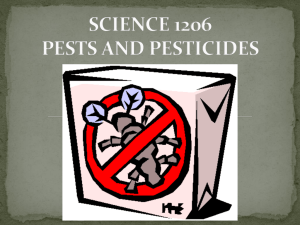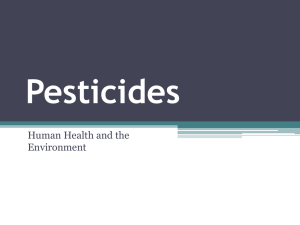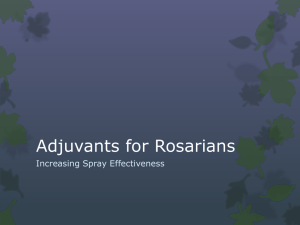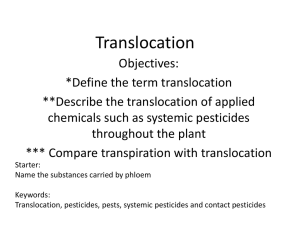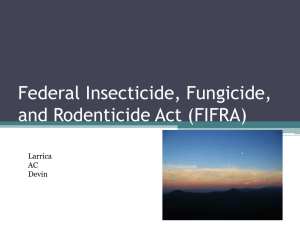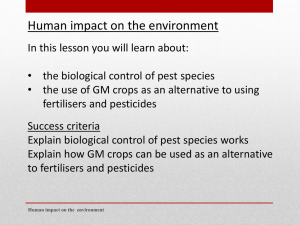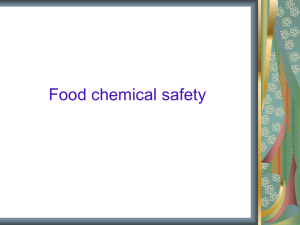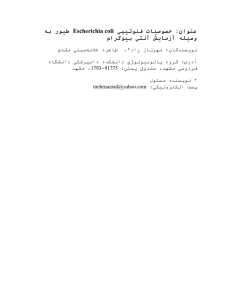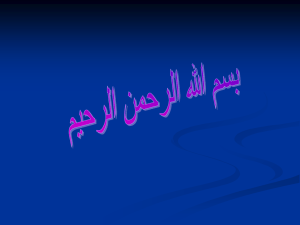اسلايد سخنراني خانم دكتر عطاپور
advertisement
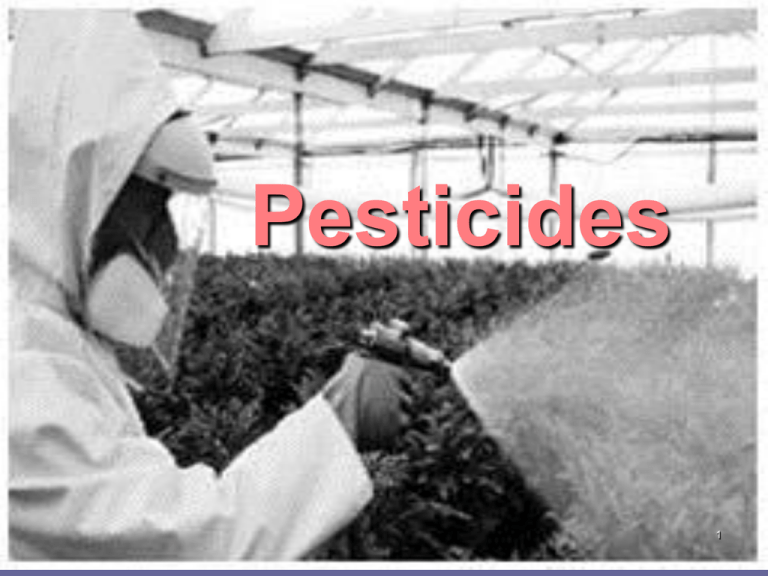
Pesticides 1 PEST = any organism that interferes in some way with human welfare or activities. 2 PESTICIDE = toxic chemicals used to reduce the size of and control the pest population. Grouped by their target organism Insecticide, Herbicide, Fungicide, Rodenticide 85% of pesticides worldwide used for Agriculture. 3 “Ideal Pesticides” Narrow-Spectrum = kill only target organism. Breaks down easily into safe materials Does not move around in the environment. “Non-Ideal Pesticides” Broad-Spectrum = kill more than just the target. Persistent or Can degrade into other cmpds that can be more dangerous Move around in the environment. 4 Pre-1940s (First-generation pesticides) Inorganics (Minerals) Contain lead, mercury, and arsenic Very persistent & bioaccumulate Organics (Botanicals) Plant-derived Break down readily Post-1940s (Second-generation pesticides) Synthetic Botanicals Made by altering natural botanicals Ex: dichlorodiphenyltrichloroethane (DDT) 5 6 INSECTICIDES : Classified by chemical structure Chlorinated Hydrocarbons = organic cmpd + Cl Broad-spectrum, persistent Most are banned (DDT, endosulfan, etc) Rachel Carson: Silent Spring Organophosphates = organic cmpd + P more poisonous than most others not persistent, so they’ve replaced most chlorinated hydrocarbons Carbamates = broad-spectrum, derived from carbamic acid Less toxic to mammals (Carbaryl, Aldicarb) 7 HERBICIDES Classified by how they act & what they kill Selective Herbicides = kill only certain types of plants Broad-leaf Herbicides 2,4-D & 2,4,5-T common in 1940s 2,4,5-T banned by EPA in 1979 due to possible harmful side effects realized after its use in the Vietnam War Grass Herbicides Nonselective Herbicides = kill all vegetation 8 VIETNAM WAR & HERBICIDES US used mixtures of herbicides to kill vegetation in S.Vietnam to expose hiding places & destroy crops planted by Vietcong: Agent White, Agent Blue, & Agent Orange Negative environmental impacts: Mangrove forests & hardwood forests destroyed Harmed ecology & economy of S.Vietnam Negative health impacts: Agent Orange = 2,4-D & 2,4,5-T combined. Created highly toxic Dioxins during creation Birth defects, stillbirths, female reproductive disorders, soft-tissue cancers Bioaccumulated in fish = very high levels in Vietnamese people 9 Benefits and Problems with Pesticides Benefit: 1:Disease control Fleas, lice and mosquitoes carry disease • Malaria- mosquito born • • • 2.7 million people die each year Few drugs available, so focus is on killing mosquitoes DDT 10 DISEASE CONTROL Malaria: carried mostly by female mosquitoes Worldwide: 300-500M people currently suffer, 2.7M die each year. DDT has helped the malaria problem greatly. Sri Lanka: went from 2M cases each year to almost zero with the use of DDT. When spraying stopped, more than 1M cases per year within 4 years. Restarted DDT spraying in 1968 DDT still used in at least 20 tropical countries to control mosquitoes. 11 Benefits and Problems with Pesticides Benefit: 2: Crop Protection Pests eat and destroy 1/3 of world’s crops Farmers save $3 to $5 for every $1 they invest in pesticides 12 Benefits and Problems with Pesticides Problem:1: Evolution of Genetic Resistance Pest populations are evolving resistance to pesticides (right) 520 insect & mite species & 84 weed species currently resistant 13 Benefits and Problems with Pesticides Problem: 2:Imbalances the Ecosystem Spraying to kill insects can affect birds, rabbits, etc. Despite 33-fold increase in pesticides since the 1940s, crop loss has not really changed 14 Ecosystem Imbalances Pesticides affect species other than intended pests. Beneficial insects, birds, and others are often killed. Indirectly responsible for killing many natural enemies of the pests (may starve/migrate looking for food after pesticide use) Kill natural enemies directly sometimes eating prey who have pesticides in their bodies 15 Benefits and Problems with Pesticides Problem:3: Creation of New Pests Infestation of red scale insects on lemons after DDT sprayed to control another pest 16 Benefits and Problems with Pesticides Problem:4: Persistence, Bioaccumulation, and Biological Magnification Bioaccumulation The buildup of a persistent pesticide or other toxic substance in an organisms body 17 • Biological magnification • Increased concentration of toxic chemicals in tissues of organisms at higher trophic levels 18 Biomagnification 19 Benefits and Problems with Pesticides Problem:5: Mobility in the Environment Do not stay where they are applied Move through soil, water and air 20 NONPOINT SOURCES Rural homes Cropland Urban streets Animal feedlot Suburban development POINT SOURCES Factory Wastewater treatment plant 21 Risk of Pesticides to Human Health Short-term Effects of Pesticides Handling food with pesticide residue • • Mild case: nausea, vomiting, headaches Severe case: damage to nervous system, 22 Long Term Effects Can cause cancer (lymphoma, leukemia, brain/lung/testicle/breast) Sterility possible. Higher rates of miscarriage Greater risk: children of ag.workers (birth defects/stunted limbs) Immune system suppression Potential link to Parkinson’s. 23 Pesticide Label Information Brand name Ingredients Formulation Signal word – DANGER, WARNING, CAUTION Directions for use Hazards to humans, animals, and the environment Personal Protective Equipment Requirements First Aid Registration number, manufacturer name/address Net contents Pesticide Ingredients The active ingredients are specified on the label. This information can help you compare different pesticide products. Inert ingredients are not identified. Signal words DANGER pesticides are extremely dangerous A very small amount of a DANGER-POISON pesticide will kill a human or pet DANGER pesticides can cause severe eye/skin injury WARNING – larger amounts will injure humans CAUTION pesticides are the least dangerous Statements of Practical Treatment Hazards to humans Hazards to domestic animals Acute effects statement (happen within 24 hours) Delayed or chronic effects statement (happen over time such as cancer) Your risk hazard from pesticide depends on the toxicity of the pesticide and your exposure to it Hazard Statements Hazards to Humans Eye, skin, inhalation, ingestion, etc. Environmental Hazards Birds, bees, groundwater, etc. Consider the hazards before you buy a pesticide. 29 Alternatives to Pesticides 1: Cultivation Methods Interplanting = alternating rows of different plants Strip Cutting = harvest one crop at a time, leaving habitat for natural predators of the pests. Planting around margins to keep habitat for natural predators. Proper timing & crop rotation 30 Alternatives to Pesticides 2: Genetic Controls Create a pest-resistant crop by crossing pestresistant plants w/ non-resistant. Problems: fungi/bacteria/pathogens evolve quickly = must keep ahead! 3: Genetically Modified (GM) Plants can be created quickly ! It could harm other parts of the environment ! Many varieties are selective. Modify the gene = more general & more widely effective! 31 Alternatives to Pesticides 4: Biological Controls use naturally occurring disease organisms/ parasites/ predators to control pests. >300 species have been introduced. Careful that new control agents don’t become pests! (weevil/thistle) Bt = soil bacterium that’s a great natural insecticide. 32 Control Using Natural Enemies 33 Alternatives to Pesticides 5: Quarantine restrict import of exotic plants/animals that may harbor pests. Effective, but not foolproof. Ex: Mediterranean Fruit Flies (medflies) in California… it’s worked, but they keep coming back! 34 Alternatives to Pesticides 6: Pheromones & Hormones Pheromones = natural substances produced by animals to stimulate a response within their species. Use to lure insects into traps! Hormones = natural chemicals produced by insects to regulate their own growth/metamorphosis. Given at wrong time: abnormal development & possible death. 35 Alternatives to Pesticides 7: Reproductive Controls Sterile Male Technique = sterilize males w/ radiation or chemicals. Disadvantages: Must be done continually to be effective - if discontinued, pest pop will rebound very quickly. Expensive! $$$$$$ 36 8: Irradiating Foods Use ionizing radiation (gamma rays from cobalt 60) on harvested food to kill harmful microorganisms First used in US: 1992 Controversial, yet mostly safe. Can cause free radicals (carcinogenic), but they normally occur produced by frying and boiling. Don’t know the long-term effects yet. 37 Integrated Pest Management (IPM) Combine many methods of pest mgmt. Pesticides are a last resort, and weak ones are used in low amts. Important for Sustainable agriculture. Used to MANAGE, not ERADICATE. Determine when pest pop reaches an economic injury threshold when benefit of taking action exceeds cost. Requires education on good strategies. Overall, IPM use is low. Knowledge to use pesticides is less than to use IPM. 38 Systems Approach- Integrated Pest Management (IPM) IPM Combination of pest control methods that keeps pest population low without economic loss Conventional pesticides are used sparingly when other methods fail 39 40 Systems Approach- Integrated Pest Management (IPM) Rice Production in Indonesia IPM Introduced 41 تعریف مقاومت ً توانايي بقاء يك حشره به غلظتي از سم كه قبال توسط آن غلظت ً كامال از بين ميرفت. 42 RR x rr Susceptible x Resistant r resistant allele R R Susceptible allele Rr Rr Mildly resistant offspring r Rr Rr Rr x Rr Heterozygous mildly resistant R R r RR dies Rr May survive r Rr May survive rr SURVIVES! 43 44 مشکالت مقاومت به سموم در حشرات 1ـ مقاومت به سموم در حشرات باعث بقای حشره در طبیعت و در نهایت ادامه خسارت اقتصادی و بهداشتی خواهد بود. 2ـ مقاومت در حشرات باعث افزایش غلظت سم برای کنترل بهتر حشرات شده در نتیجه از نظر اقتصادی ،بار مالی بیشتری برای انسان داشته و آلودگی محیط زیست را نیز افزایش میدهد. 3ـ استفاده بیشتر از سموم باعث آلودگی محیط زیست شده و موجودات غیرهدف مثل حشرات مفید و موجوداتی که در سیر تکاملی جانوران و طبیعت نقش اساس ی دارند را از بین میبرد. 4ـ سموم استفاده شده ،وارد چرخه تغذیه انسان و حیوانات شده و ناهنجاری های متفاوتی را باعث میگردد. 5ـ مقاومت به سموم ،انسان را وادار به سرمایهگذاری در جهت کشف سموم جدید مینماید که این ً مسئله کامال مقرون به صرفه نمیباشد. 6ـ مقاومت به سموم در حشرات باعث بازپدیدی بیماری های مختلفی که توسط حشرات به انسان منتقل میشوند گردیده است .بطور مثال بازپدیدی و تداوم ماالریا یکی از نمونههای بارز مقاومت پشه آنوفل به سموم است. 45 Pesticide Treadmill Cost of applying pesticide increases Because they must be applied more frequently or in larger doses While their effectiveness decreases Because of increased genetic resistance in pests 46 مکانیسم های مقاومت به سموم در حشرات -1کاهش نفوذ سم )(Reduced penetration -2مقاومت از طریق شکست سم توسط آنزیم های حشره)(Metabolic resistance -3تغییر در سیستم هدف در حشرات )(Target site insensitivity -4تغییرات رفتاری)(Behavior change -5دفع سم)(excretion 47 فاکتورهائی که در مقاومت به سموم نقش دارند 1ـ فاکتورهای ژنتیکی مانند جهش ,فراوانی ژنهای غالب مقاومت 2ـ فاکتورهای تولید مثلی مانند تعداد نسل در سال ,اندازه جمعیت حشرات ,تعداد جفتگیری ,بکرزائی و غیره 3ـ فاکتورهای رفتاری اکولوژیکی مانند مهاجرت حشرات ,فرار از حشرهکش ,اثر مواد طبیعی و آنزیمهای شکنندة سم ,عادات درون خواری و برونخواری 4ـ فاکتورهای سمپاش ی مثل سابقه استفاده از سموم ,قسمتی از جمعیت که تحت تأثیر سم قرار میگیرند ,غلظت حشرهکش استفاده شده ,خاصیت ابقائی سم ,راه تماس ,مرحلهای از رشد حشره که در تماس با سم قرار میگیرد .اثرات متقابل سموم با عوامل کنترل کننده محیطی ,استفاده از مخلوط دو سم, الگوی سمپاش ی ,رهاسازی حشرات نر عقیم. 48 مدیریت مقاومت 1ـ تغیير دادن غلظت حشره کش و دفعات سمپاش ی 2ـ استفاده از سموم در مواقع ضروری و بصورت منطقهای 3ـ استفاده از سموم در جائی که اپیدمی حاصل میشود 4ـ استفاده از سموم با خاصیت ابقائی کمتر 5ـ استفاده از سموم برای کنترل بخش ی از سیکل زندگی حشره مثل الرو یا حشره کامل 6ـ استفاده از مخلوط دو سم 7ـ جایگزینی سموم 8ـ استفاده از سموم بصورتrotation 9ـ استفاده از فرموالسیون های مناسب سموم 10ـ استفاده از سینرژیستها 11ـ کشف سم جدید با مکانیسم عمل متفاوت 12ـ استفاده از روش های کنترل غيرشیمیایی 49 فرومون ها Pheromones 50 جایگزینی،استفاده از فرومون ها در کنترل آفات مناسب برای سموم شیمیایی ترشحات غدد برون ریز ترشحات غدد درون ریز • Pheromones = natural • Hormones = natural substances produced by animals to stimulate a response within their species. Use to lure insects into traps! chemicals produced by insects to regulate their own growth/metamorphosis. Given at wrong time: abnormal development & possible death. 51 اطالع رسان های شیمیایی مواد شيمايي هستند كه توسط يك موجود زنده (نظير گياهان، حشرات و غيره) متصاعد شده و سبب بروز رفتار يا پاسخ فيزيولوژيكي در افراد ديگر مي گردد .اين تركيبات را مي توان به دو گروه تقسيم نمود : اطالع رسان هاي شيميايي )(Semiochemicals ارتباط درون گونه اي فرومون ها )(Pheromones -فرومون جنس ي آللوكميكال ها )(Alelochemicals -فرومون تجمعي -آلومون (به نفع توليد كننده) -فرومون اعالم خطر -كايرومون (به نفع گيرنده) فرومون رديابيفرومون عالمت گذاري ميزبان52 ارتباط بين گونه اي -سينومون (به نفع توليد كننده و گيرنده) مزایای استفاده از فرومون ها در مديريت تلفيقي آفات ً -1اين تركيبات به صورت طبيعي موجود هستند و بنابراين كامال با محيط زيست سازگارند -2مي توانند در مسافت هاي طوالني منتشر شده و به سرعت عمل كنند -3هيچگونه خطري براي سالمتي انسان يا محيط زيست ايجاد نمي كنند 53 استفاده از فرومون ها در مديريت تلفيقي آفات -1پايش ()Monitoring به طور كلي پايش حشرات به سه منظور صورت مي گيرد: الف :بررس ي وجود يك آفت در منطقه، ب :تخمين جمعيت نسبي يك آفت در محل و ج :تعيين زمان ظهور يا پيك پرواز يك گونه مشخص در منطقه. از انواع تله هاي فروموني مي توان در اين سه منظور بهره جست و پس از آن مي توان با كمك و تلفيق ساير روش ها آفت را كنترل نمود. 54 استفاده از فرومون ها در مديريت تلفيقي آفات -2اختالل در جفت گيري ()Mating Disruption اين روش كه در آن از فرومون جنس ي مختص يك گونه در مقادير بسيار با اال استفاده مي شود بيشتر در مورد آفات بالپولكداران و در باغ ها استفاده مي شود .در این روش با رهاسازي مقادير بااليي از فرومون سنتز شده در محيط، در جستجوي حشرات نر براي يافتن جنس ماده اختالل ايجاد شده و در نتيجه ميزان جفتگيري و به دنبال آن تخم ريزي كاهش مي يابد. 55 استفاده از فرومون ها در مديريت تلفيقي آفات -3شکار شكار حشرات آفت با كمك تله هاي فروموني پس از مرحله پايش مي تواند منجر به حذف تعداد بااليي از آفات مورد نظر در منطقه گردد .در اين تله ها اتژي مي توان همزمان عالوه بر فرومون از يك سم نيز استفاده نمود (استر ا )Lure and Killكه به اين ترتيب عالوه بر نابودي آفات ،از تماس مستقيم سم با محصول نيز جلوگيري مي شود .اين تكنيك در مورد آفات انباري نيز به خوبي قابل استفاده است. 56 تله دلتا 57 تله بالی 58 انواع تله های قیفی 59 تله دام 60 تله مکفیل سراتراپ مشکالت استفاده از فرومون ها در مديريت تلفيقي آفات •از آنجا که فرومون ها ترکیبات بسیار اختصاص ی هستند تولید آنها به طور مصنوعی بسیار دشوار است. •غلظت موادي كه رهاسازي مي شود بايستي آنقدر باشد كه توسط حشره درك شود. ن) بايستي از موادي تهيه ش اوند كه •ديسپنسرها (كپسول پخش كننده فرومو ا توليد آنها به راحتي امكان پذير باشد. •رهاسازي اين مواد مي بايست در تمام طول دوره حضور آفت انجام گيرد 61

